Position Paper: Strategies for Addressing Nursing Shortage in Canada
VerifiedAdded on 2022/08/24
|17
|4147
|14
Report
AI Summary
This position paper examines the critical issue of the nursing shortage in Canada, exploring its causes, consequences, and potential solutions. The paper begins by defining the nursing shortage and its measurement, highlighting the discrepancy between the demand for nurses and the available supply. It then presents a counterargument, acknowledging the challenges of sustainable nursing job openings and hospital budget cuts. The paper proceeds to argue that the shortage is a significant problem, citing the Canadian Nurses Association's warning of a severe shortage and its impact on healthcare quality, job turnover, and patient satisfaction. It presents statistics from CIHI and RNAO, illustrating the decline in RNs and the shift towards RPNs. The arguments emphasize the impact of nursing shortages on patient care quality, increased mortality rates, and the need for adequate staffing levels to ensure patient safety. The paper concludes by underscoring the importance of addressing the shortage to maintain quality healthcare services.
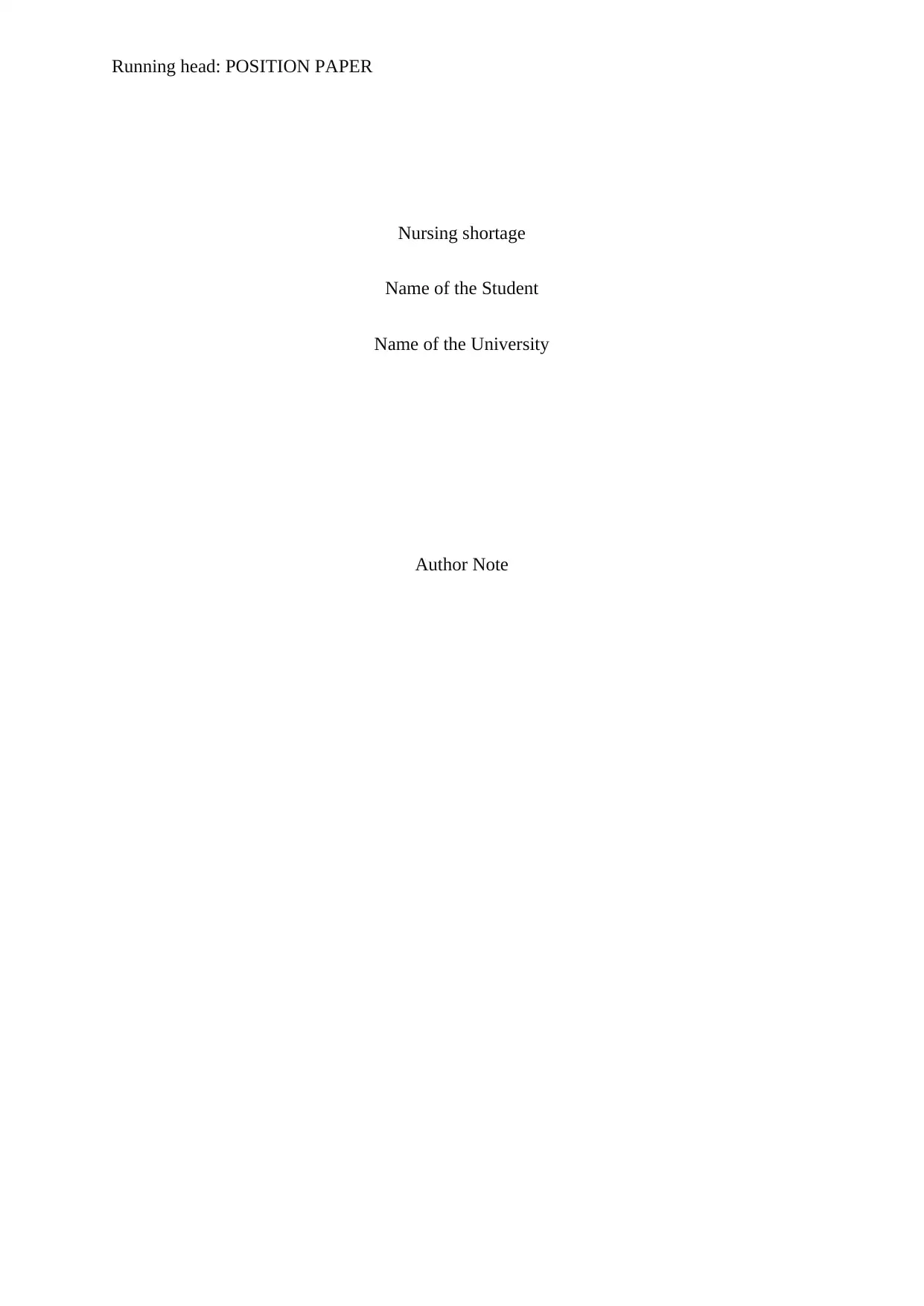
Running head: POSITION PAPER
Nursing shortage
Name of the Student
Name of the University
Author Note
Nursing shortage
Name of the Student
Name of the University
Author Note
Paraphrase This Document
Need a fresh take? Get an instant paraphrase of this document with our AI Paraphraser
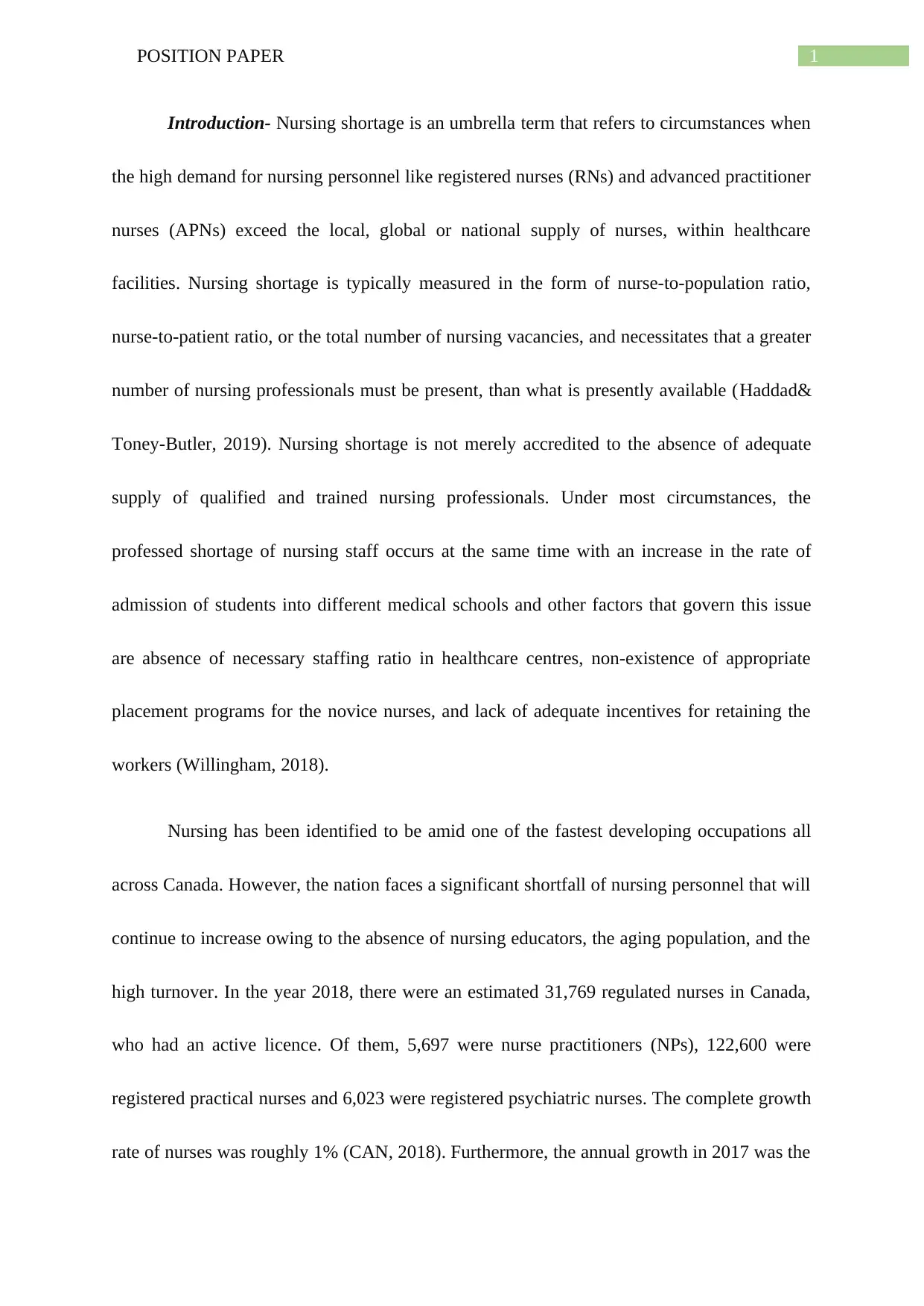
1POSITION PAPER
Introduction- Nursing shortage is an umbrella term that refers to circumstances when
the high demand for nursing personnel like registered nurses (RNs) and advanced practitioner
nurses (APNs) exceed the local, global or national supply of nurses, within healthcare
facilities. Nursing shortage is typically measured in the form of nurse-to-population ratio,
nurse-to-patient ratio, or the total number of nursing vacancies, and necessitates that a greater
number of nursing professionals must be present, than what is presently available (Haddad&
Toney-Butler, 2019). Nursing shortage is not merely accredited to the absence of adequate
supply of qualified and trained nursing professionals. Under most circumstances, the
professed shortage of nursing staff occurs at the same time with an increase in the rate of
admission of students into different medical schools and other factors that govern this issue
are absence of necessary staffing ratio in healthcare centres, non-existence of appropriate
placement programs for the novice nurses, and lack of adequate incentives for retaining the
workers (Willingham, 2018).
Nursing has been identified to be amid one of the fastest developing occupations all
across Canada. However, the nation faces a significant shortfall of nursing personnel that will
continue to increase owing to the absence of nursing educators, the aging population, and the
high turnover. In the year 2018, there were an estimated 31,769 regulated nurses in Canada,
who had an active licence. Of them, 5,697 were nurse practitioners (NPs), 122,600 were
registered practical nurses and 6,023 were registered psychiatric nurses. The complete growth
rate of nurses was roughly 1% (CAN, 2018). Furthermore, the annual growth in 2017 was the
Introduction- Nursing shortage is an umbrella term that refers to circumstances when
the high demand for nursing personnel like registered nurses (RNs) and advanced practitioner
nurses (APNs) exceed the local, global or national supply of nurses, within healthcare
facilities. Nursing shortage is typically measured in the form of nurse-to-population ratio,
nurse-to-patient ratio, or the total number of nursing vacancies, and necessitates that a greater
number of nursing professionals must be present, than what is presently available (Haddad&
Toney-Butler, 2019). Nursing shortage is not merely accredited to the absence of adequate
supply of qualified and trained nursing professionals. Under most circumstances, the
professed shortage of nursing staff occurs at the same time with an increase in the rate of
admission of students into different medical schools and other factors that govern this issue
are absence of necessary staffing ratio in healthcare centres, non-existence of appropriate
placement programs for the novice nurses, and lack of adequate incentives for retaining the
workers (Willingham, 2018).
Nursing has been identified to be amid one of the fastest developing occupations all
across Canada. However, the nation faces a significant shortfall of nursing personnel that will
continue to increase owing to the absence of nursing educators, the aging population, and the
high turnover. In the year 2018, there were an estimated 31,769 regulated nurses in Canada,
who had an active licence. Of them, 5,697 were nurse practitioners (NPs), 122,600 were
registered practical nurses and 6,023 were registered psychiatric nurses. The complete growth
rate of nurses was roughly 1% (CAN, 2018). Furthermore, the annual growth in 2017 was the
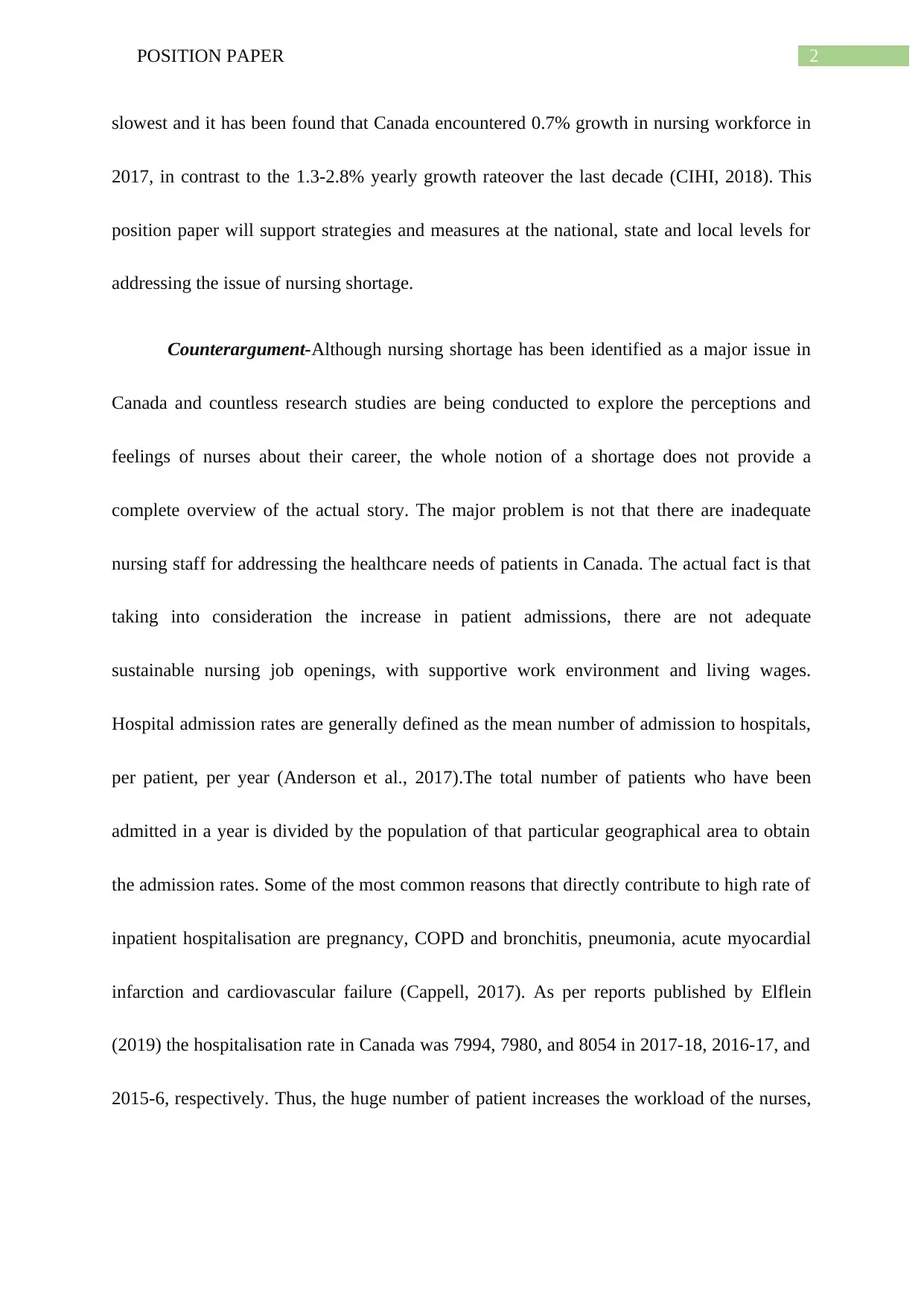
2POSITION PAPER
slowest and it has been found that Canada encountered 0.7% growth in nursing workforce in
2017, in contrast to the 1.3-2.8% yearly growth rateover the last decade (CIHI, 2018). This
position paper will support strategies and measures at the national, state and local levels for
addressing the issue of nursing shortage.
Counterargument-Although nursing shortage has been identified as a major issue in
Canada and countless research studies are being conducted to explore the perceptions and
feelings of nurses about their career, the whole notion of a shortage does not provide a
complete overview of the actual story. The major problem is not that there are inadequate
nursing staff for addressing the healthcare needs of patients in Canada. The actual fact is that
taking into consideration the increase in patient admissions, there are not adequate
sustainable nursing job openings, with supportive work environment and living wages.
Hospital admission rates are generally defined as the mean number of admission to hospitals,
per patient, per year (Anderson et al., 2017).The total number of patients who have been
admitted in a year is divided by the population of that particular geographical area to obtain
the admission rates. Some of the most common reasons that directly contribute to high rate of
inpatient hospitalisation are pregnancy, COPD and bronchitis, pneumonia, acute myocardial
infarction and cardiovascular failure (Cappell, 2017). As per reports published by Elflein
(2019) the hospitalisation rate in Canada was 7994, 7980, and 8054 in 2017-18, 2016-17, and
2015-6, respectively. Thus, the huge number of patient increases the workload of the nurses,
slowest and it has been found that Canada encountered 0.7% growth in nursing workforce in
2017, in contrast to the 1.3-2.8% yearly growth rateover the last decade (CIHI, 2018). This
position paper will support strategies and measures at the national, state and local levels for
addressing the issue of nursing shortage.
Counterargument-Although nursing shortage has been identified as a major issue in
Canada and countless research studies are being conducted to explore the perceptions and
feelings of nurses about their career, the whole notion of a shortage does not provide a
complete overview of the actual story. The major problem is not that there are inadequate
nursing staff for addressing the healthcare needs of patients in Canada. The actual fact is that
taking into consideration the increase in patient admissions, there are not adequate
sustainable nursing job openings, with supportive work environment and living wages.
Hospital admission rates are generally defined as the mean number of admission to hospitals,
per patient, per year (Anderson et al., 2017).The total number of patients who have been
admitted in a year is divided by the population of that particular geographical area to obtain
the admission rates. Some of the most common reasons that directly contribute to high rate of
inpatient hospitalisation are pregnancy, COPD and bronchitis, pneumonia, acute myocardial
infarction and cardiovascular failure (Cappell, 2017). As per reports published by Elflein
(2019) the hospitalisation rate in Canada was 7994, 7980, and 8054 in 2017-18, 2016-17, and
2015-6, respectively. Thus, the huge number of patient increases the workload of the nurses,
⊘ This is a preview!⊘
Do you want full access?
Subscribe today to unlock all pages.

Trusted by 1+ million students worldwide
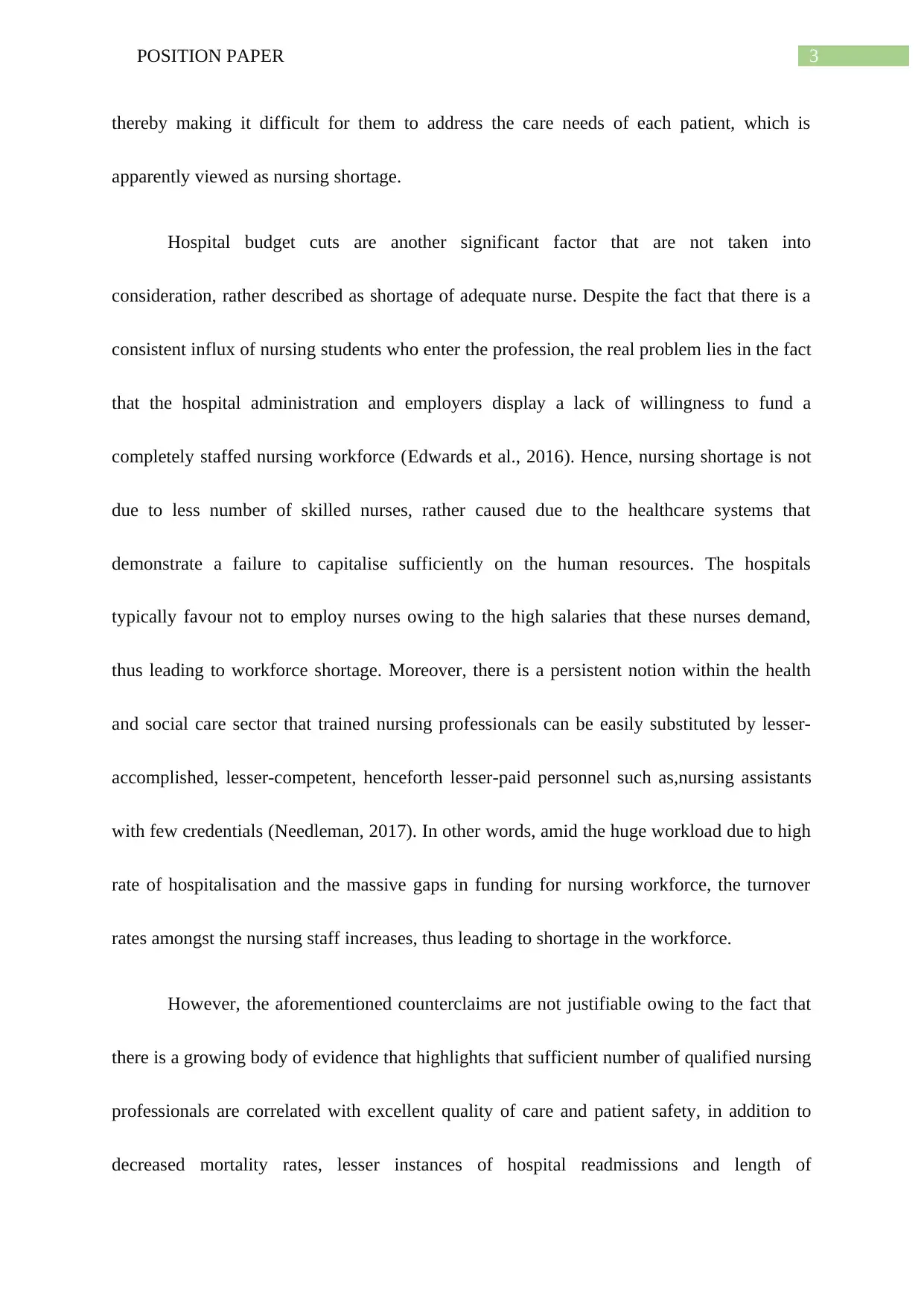
3POSITION PAPER
thereby making it difficult for them to address the care needs of each patient, which is
apparently viewed as nursing shortage.
Hospital budget cuts are another significant factor that are not taken into
consideration, rather described as shortage of adequate nurse. Despite the fact that there is a
consistent influx of nursing students who enter the profession, the real problem lies in the fact
that the hospital administration and employers display a lack of willingness to fund a
completely staffed nursing workforce (Edwards et al., 2016). Hence, nursing shortage is not
due to less number of skilled nurses, rather caused due to the healthcare systems that
demonstrate a failure to capitalise sufficiently on the human resources. The hospitals
typically favour not to employ nurses owing to the high salaries that these nurses demand,
thus leading to workforce shortage. Moreover, there is a persistent notion within the health
and social care sector that trained nursing professionals can be easily substituted by lesser-
accomplished, lesser-competent, henceforth lesser-paid personnel such as,nursing assistants
with few credentials (Needleman, 2017). In other words, amid the huge workload due to high
rate of hospitalisation and the massive gaps in funding for nursing workforce, the turnover
rates amongst the nursing staff increases, thus leading to shortage in the workforce.
However, the aforementioned counterclaims are not justifiable owing to the fact that
there is a growing body of evidence that highlights that sufficient number of qualified nursing
professionals are correlated with excellent quality of care and patient safety, in addition to
decreased mortality rates, lesser instances of hospital readmissions and length of
thereby making it difficult for them to address the care needs of each patient, which is
apparently viewed as nursing shortage.
Hospital budget cuts are another significant factor that are not taken into
consideration, rather described as shortage of adequate nurse. Despite the fact that there is a
consistent influx of nursing students who enter the profession, the real problem lies in the fact
that the hospital administration and employers display a lack of willingness to fund a
completely staffed nursing workforce (Edwards et al., 2016). Hence, nursing shortage is not
due to less number of skilled nurses, rather caused due to the healthcare systems that
demonstrate a failure to capitalise sufficiently on the human resources. The hospitals
typically favour not to employ nurses owing to the high salaries that these nurses demand,
thus leading to workforce shortage. Moreover, there is a persistent notion within the health
and social care sector that trained nursing professionals can be easily substituted by lesser-
accomplished, lesser-competent, henceforth lesser-paid personnel such as,nursing assistants
with few credentials (Needleman, 2017). In other words, amid the huge workload due to high
rate of hospitalisation and the massive gaps in funding for nursing workforce, the turnover
rates amongst the nursing staff increases, thus leading to shortage in the workforce.
However, the aforementioned counterclaims are not justifiable owing to the fact that
there is a growing body of evidence that highlights that sufficient number of qualified nursing
professionals are correlated with excellent quality of care and patient safety, in addition to
decreased mortality rates, lesser instances of hospital readmissions and length of
Paraphrase This Document
Need a fresh take? Get an instant paraphrase of this document with our AI Paraphraser
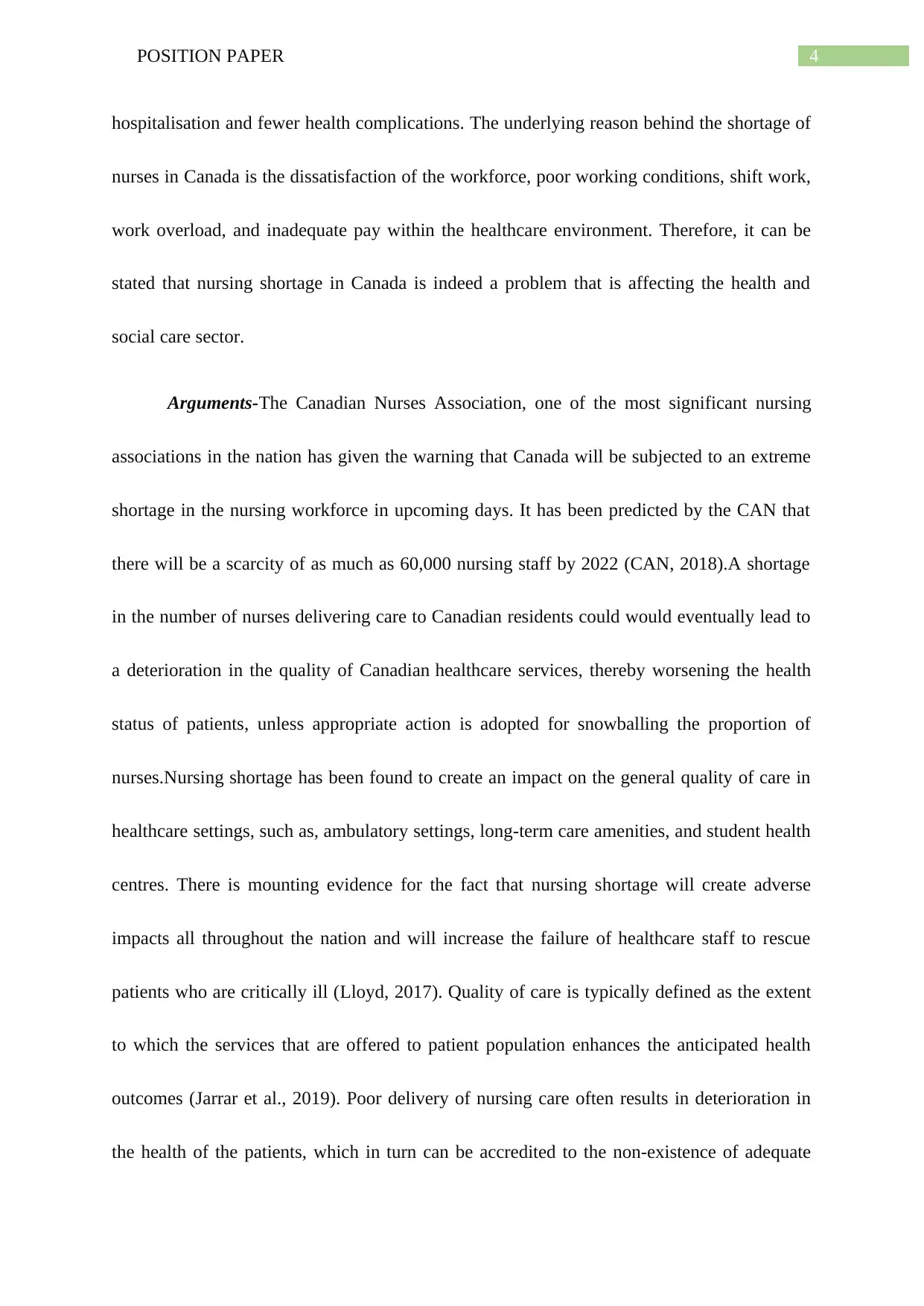
4POSITION PAPER
hospitalisation and fewer health complications. The underlying reason behind the shortage of
nurses in Canada is the dissatisfaction of the workforce, poor working conditions, shift work,
work overload, and inadequate pay within the healthcare environment. Therefore, it can be
stated that nursing shortage in Canada is indeed a problem that is affecting the health and
social care sector.
Arguments-The Canadian Nurses Association, one of the most significant nursing
associations in the nation has given the warning that Canada will be subjected to an extreme
shortage in the nursing workforce in upcoming days. It has been predicted by the CAN that
there will be a scarcity of as much as 60,000 nursing staff by 2022 (CAN, 2018).A shortage
in the number of nurses delivering care to Canadian residents could would eventually lead to
a deterioration in the quality of Canadian healthcare services, thereby worsening the health
status of patients, unless appropriate action is adopted for snowballing the proportion of
nurses.Nursing shortage has been found to create an impact on the general quality of care in
healthcare settings, such as, ambulatory settings, long-term care amenities, and student health
centres. There is mounting evidence for the fact that nursing shortage will create adverse
impacts all throughout the nation and will increase the failure of healthcare staff to rescue
patients who are critically ill (Lloyd, 2017). Quality of care is typically defined as the extent
to which the services that are offered to patient population enhances the anticipated health
outcomes (Jarrar et al., 2019). Poor delivery of nursing care often results in deterioration in
the health of the patients, which in turn can be accredited to the non-existence of adequate
hospitalisation and fewer health complications. The underlying reason behind the shortage of
nurses in Canada is the dissatisfaction of the workforce, poor working conditions, shift work,
work overload, and inadequate pay within the healthcare environment. Therefore, it can be
stated that nursing shortage in Canada is indeed a problem that is affecting the health and
social care sector.
Arguments-The Canadian Nurses Association, one of the most significant nursing
associations in the nation has given the warning that Canada will be subjected to an extreme
shortage in the nursing workforce in upcoming days. It has been predicted by the CAN that
there will be a scarcity of as much as 60,000 nursing staff by 2022 (CAN, 2018).A shortage
in the number of nurses delivering care to Canadian residents could would eventually lead to
a deterioration in the quality of Canadian healthcare services, thereby worsening the health
status of patients, unless appropriate action is adopted for snowballing the proportion of
nurses.Nursing shortage has been found to create an impact on the general quality of care in
healthcare settings, such as, ambulatory settings, long-term care amenities, and student health
centres. There is mounting evidence for the fact that nursing shortage will create adverse
impacts all throughout the nation and will increase the failure of healthcare staff to rescue
patients who are critically ill (Lloyd, 2017). Quality of care is typically defined as the extent
to which the services that are offered to patient population enhances the anticipated health
outcomes (Jarrar et al., 2019). Poor delivery of nursing care often results in deterioration in
the health of the patients, which in turn can be accredited to the non-existence of adequate
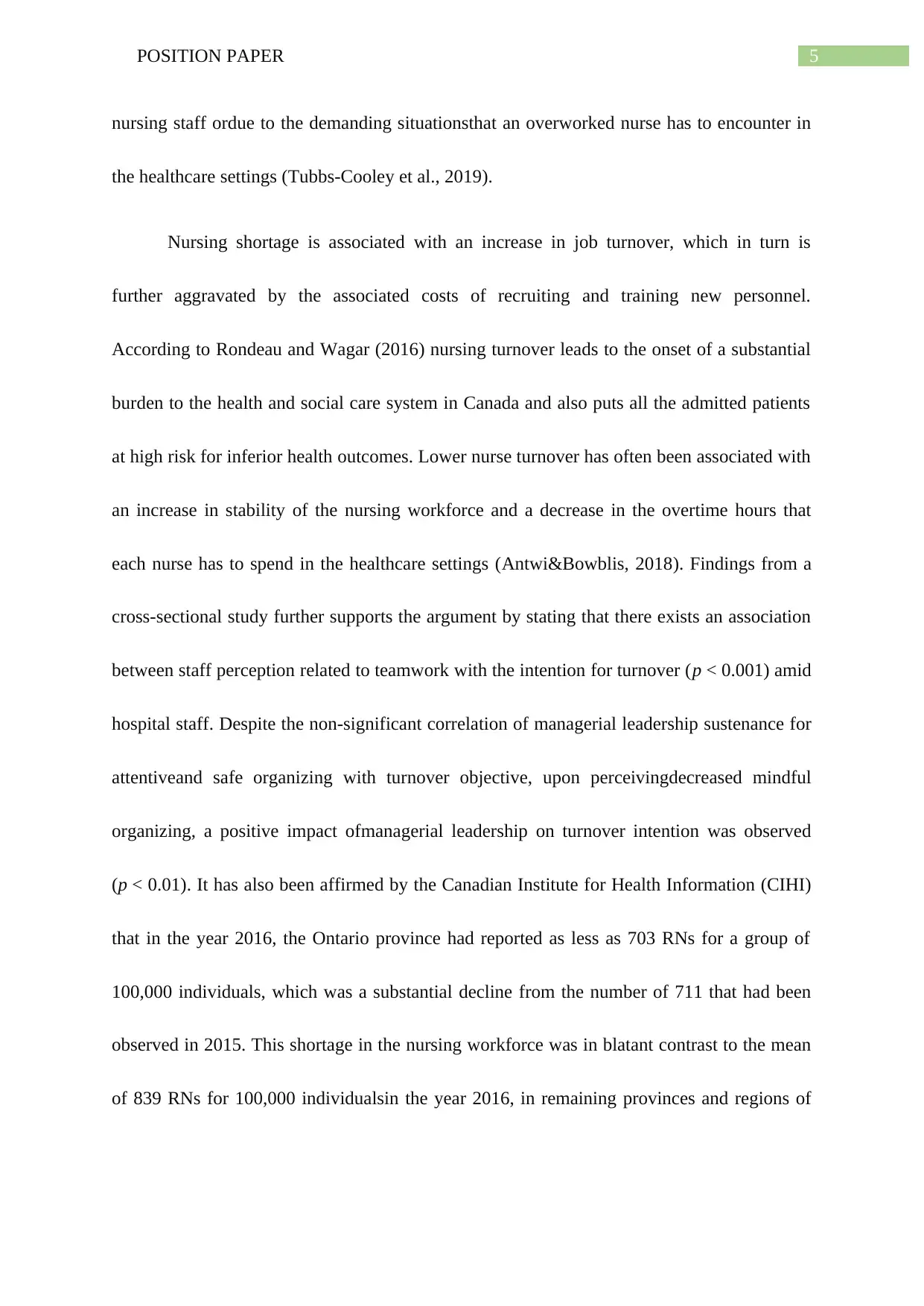
5POSITION PAPER
nursing staff ordue to the demanding situationsthat an overworked nurse has to encounter in
the healthcare settings (Tubbs-Cooley et al., 2019).
Nursing shortage is associated with an increase in job turnover, which in turn is
further aggravated by the associated costs of recruiting and training new personnel.
According to Rondeau and Wagar (2016) nursing turnover leads to the onset of a substantial
burden to the health and social care system in Canada and also puts all the admitted patients
at high risk for inferior health outcomes. Lower nurse turnover has often been associated with
an increase in stability of the nursing workforce and a decrease in the overtime hours that
each nurse has to spend in the healthcare settings (Antwi&Bowblis, 2018). Findings from a
cross-sectional study further supports the argument by stating that there exists an association
between staff perception related to teamwork with the intention for turnover (p < 0.001) amid
hospital staff. Despite the non-significant correlation of managerial leadership sustenance for
attentiveand safe organizing with turnover objective, upon perceivingdecreased mindful
organizing, a positive impact ofmanagerial leadership on turnover intention was observed
(p < 0.01). It has also been affirmed by the Canadian Institute for Health Information (CIHI)
that in the year 2016, the Ontario province had reported as less as 703 RNs for a group of
100,000 individuals, which was a substantial decline from the number of 711 that had been
observed in 2015. This shortage in the nursing workforce was in blatant contrast to the mean
of 839 RNs for 100,000 individualsin the year 2016, in remaining provinces and regions of
nursing staff ordue to the demanding situationsthat an overworked nurse has to encounter in
the healthcare settings (Tubbs-Cooley et al., 2019).
Nursing shortage is associated with an increase in job turnover, which in turn is
further aggravated by the associated costs of recruiting and training new personnel.
According to Rondeau and Wagar (2016) nursing turnover leads to the onset of a substantial
burden to the health and social care system in Canada and also puts all the admitted patients
at high risk for inferior health outcomes. Lower nurse turnover has often been associated with
an increase in stability of the nursing workforce and a decrease in the overtime hours that
each nurse has to spend in the healthcare settings (Antwi&Bowblis, 2018). Findings from a
cross-sectional study further supports the argument by stating that there exists an association
between staff perception related to teamwork with the intention for turnover (p < 0.001) amid
hospital staff. Despite the non-significant correlation of managerial leadership sustenance for
attentiveand safe organizing with turnover objective, upon perceivingdecreased mindful
organizing, a positive impact ofmanagerial leadership on turnover intention was observed
(p < 0.01). It has also been affirmed by the Canadian Institute for Health Information (CIHI)
that in the year 2016, the Ontario province had reported as less as 703 RNs for a group of
100,000 individuals, which was a substantial decline from the number of 711 that had been
observed in 2015. This shortage in the nursing workforce was in blatant contrast to the mean
of 839 RNs for 100,000 individualsin the year 2016, in remaining provinces and regions of
⊘ This is a preview!⊘
Do you want full access?
Subscribe today to unlock all pages.

Trusted by 1+ million students worldwide
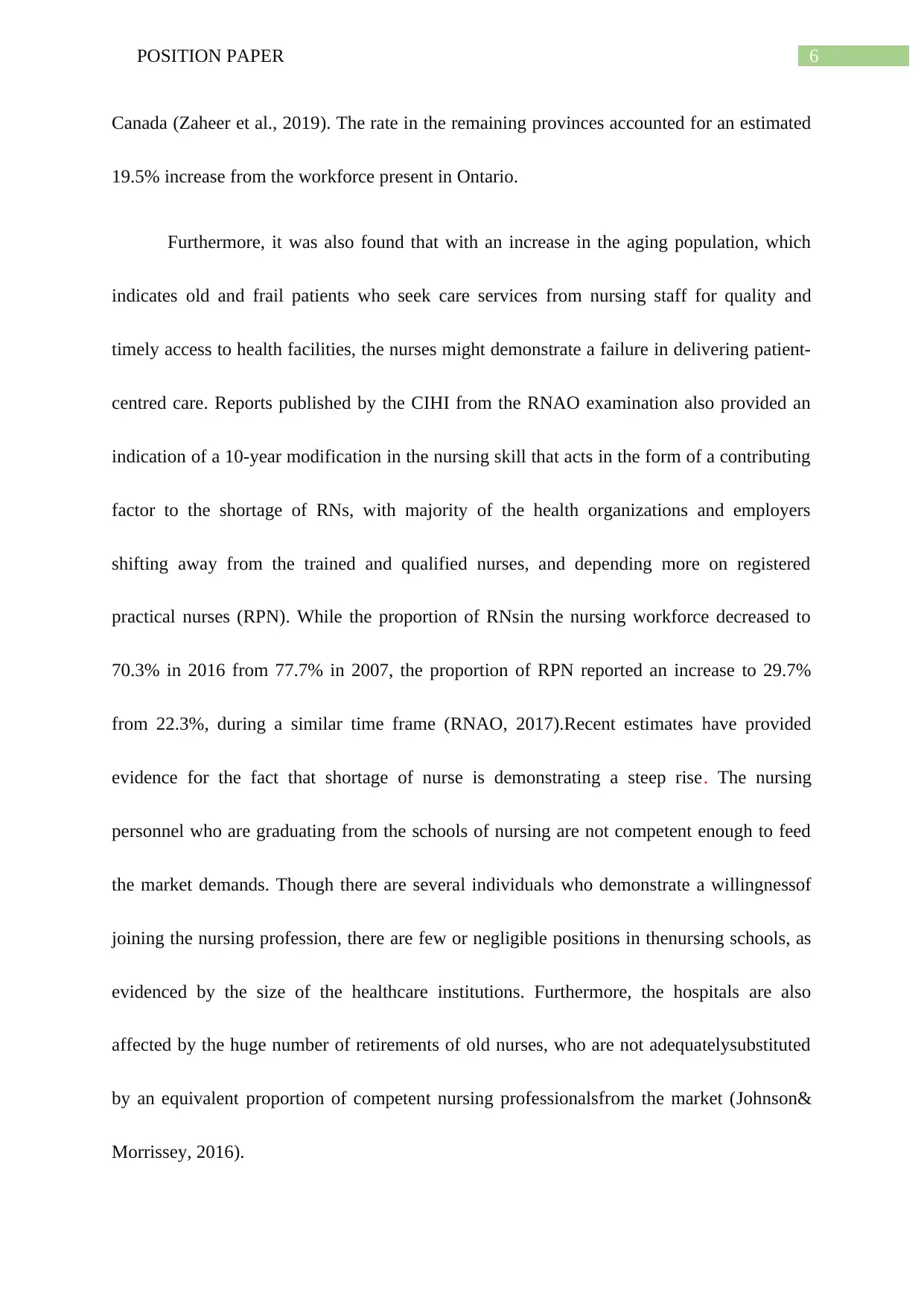
6POSITION PAPER
Canada (Zaheer et al., 2019). The rate in the remaining provinces accounted for an estimated
19.5% increase from the workforce present in Ontario.
Furthermore, it was also found that with an increase in the aging population, which
indicates old and frail patients who seek care services from nursing staff for quality and
timely access to health facilities, the nurses might demonstrate a failure in delivering patient-
centred care. Reports published by the CIHI from the RNAO examination also provided an
indication of a 10-year modification in the nursing skill that acts in the form of a contributing
factor to the shortage of RNs, with majority of the health organizations and employers
shifting away from the trained and qualified nurses, and depending more on registered
practical nurses (RPN). While the proportion of RNsin the nursing workforce decreased to
70.3% in 2016 from 77.7% in 2007, the proportion of RPN reported an increase to 29.7%
from 22.3%, during a similar time frame (RNAO, 2017).Recent estimates have provided
evidence for the fact that shortage of nurse is demonstrating a steep rise. The nursing
personnel who are graduating from the schools of nursing are not competent enough to feed
the market demands. Though there are several individuals who demonstrate a willingnessof
joining the nursing profession, there are few or negligible positions in thenursing schools, as
evidenced by the size of the healthcare institutions. Furthermore, the hospitals are also
affected by the huge number of retirements of old nurses, who are not adequatelysubstituted
by an equivalent proportion of competent nursing professionalsfrom the market (Johnson&
Morrissey, 2016).
Canada (Zaheer et al., 2019). The rate in the remaining provinces accounted for an estimated
19.5% increase from the workforce present in Ontario.
Furthermore, it was also found that with an increase in the aging population, which
indicates old and frail patients who seek care services from nursing staff for quality and
timely access to health facilities, the nurses might demonstrate a failure in delivering patient-
centred care. Reports published by the CIHI from the RNAO examination also provided an
indication of a 10-year modification in the nursing skill that acts in the form of a contributing
factor to the shortage of RNs, with majority of the health organizations and employers
shifting away from the trained and qualified nurses, and depending more on registered
practical nurses (RPN). While the proportion of RNsin the nursing workforce decreased to
70.3% in 2016 from 77.7% in 2007, the proportion of RPN reported an increase to 29.7%
from 22.3%, during a similar time frame (RNAO, 2017).Recent estimates have provided
evidence for the fact that shortage of nurse is demonstrating a steep rise. The nursing
personnel who are graduating from the schools of nursing are not competent enough to feed
the market demands. Though there are several individuals who demonstrate a willingnessof
joining the nursing profession, there are few or negligible positions in thenursing schools, as
evidenced by the size of the healthcare institutions. Furthermore, the hospitals are also
affected by the huge number of retirements of old nurses, who are not adequatelysubstituted
by an equivalent proportion of competent nursing professionalsfrom the market (Johnson&
Morrissey, 2016).
Paraphrase This Document
Need a fresh take? Get an instant paraphrase of this document with our AI Paraphraser
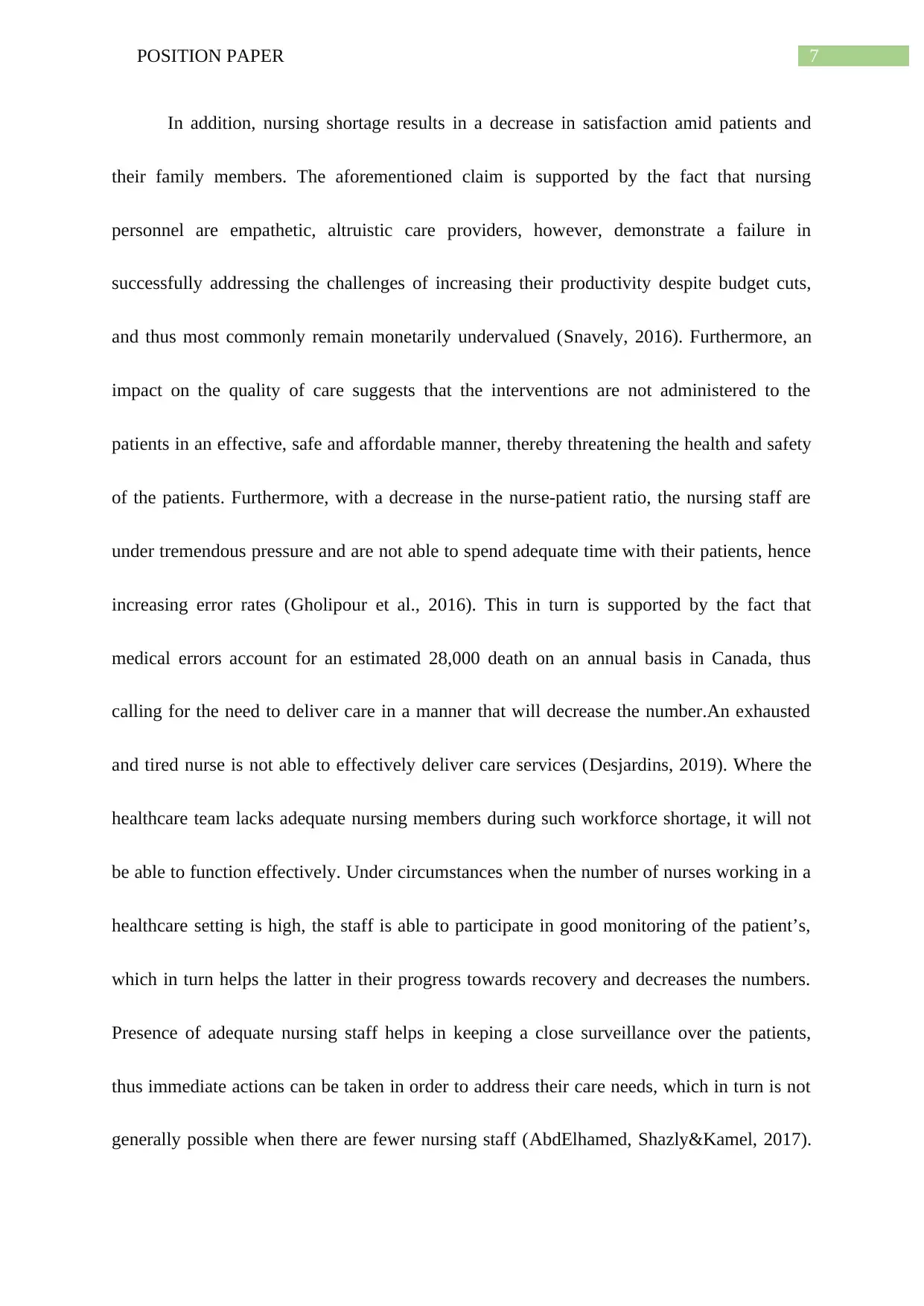
7POSITION PAPER
In addition, nursing shortage results in a decrease in satisfaction amid patients and
their family members. The aforementioned claim is supported by the fact that nursing
personnel are empathetic, altruistic care providers, however, demonstrate a failure in
successfully addressing the challenges of increasing their productivity despite budget cuts,
and thus most commonly remain monetarily undervalued (Snavely, 2016). Furthermore, an
impact on the quality of care suggests that the interventions are not administered to the
patients in an effective, safe and affordable manner, thereby threatening the health and safety
of the patients. Furthermore, with a decrease in the nurse-patient ratio, the nursing staff are
under tremendous pressure and are not able to spend adequate time with their patients, hence
increasing error rates (Gholipour et al., 2016). This in turn is supported by the fact that
medical errors account for an estimated 28,000 death on an annual basis in Canada, thus
calling for the need to deliver care in a manner that will decrease the number.An exhausted
and tired nurse is not able to effectively deliver care services (Desjardins, 2019). Where the
healthcare team lacks adequate nursing members during such workforce shortage, it will not
be able to function effectively. Under circumstances when the number of nurses working in a
healthcare setting is high, the staff is able to participate in good monitoring of the patient’s,
which in turn helps the latter in their progress towards recovery and decreases the numbers.
Presence of adequate nursing staff helps in keeping a close surveillance over the patients,
thus immediate actions can be taken in order to address their care needs, which in turn is not
generally possible when there are fewer nursing staff (AbdElhamed, Shazly&Kamel, 2017).
In addition, nursing shortage results in a decrease in satisfaction amid patients and
their family members. The aforementioned claim is supported by the fact that nursing
personnel are empathetic, altruistic care providers, however, demonstrate a failure in
successfully addressing the challenges of increasing their productivity despite budget cuts,
and thus most commonly remain monetarily undervalued (Snavely, 2016). Furthermore, an
impact on the quality of care suggests that the interventions are not administered to the
patients in an effective, safe and affordable manner, thereby threatening the health and safety
of the patients. Furthermore, with a decrease in the nurse-patient ratio, the nursing staff are
under tremendous pressure and are not able to spend adequate time with their patients, hence
increasing error rates (Gholipour et al., 2016). This in turn is supported by the fact that
medical errors account for an estimated 28,000 death on an annual basis in Canada, thus
calling for the need to deliver care in a manner that will decrease the number.An exhausted
and tired nurse is not able to effectively deliver care services (Desjardins, 2019). Where the
healthcare team lacks adequate nursing members during such workforce shortage, it will not
be able to function effectively. Under circumstances when the number of nurses working in a
healthcare setting is high, the staff is able to participate in good monitoring of the patient’s,
which in turn helps the latter in their progress towards recovery and decreases the numbers.
Presence of adequate nursing staff helps in keeping a close surveillance over the patients,
thus immediate actions can be taken in order to address their care needs, which in turn is not
generally possible when there are fewer nursing staff (AbdElhamed, Shazly&Kamel, 2017).
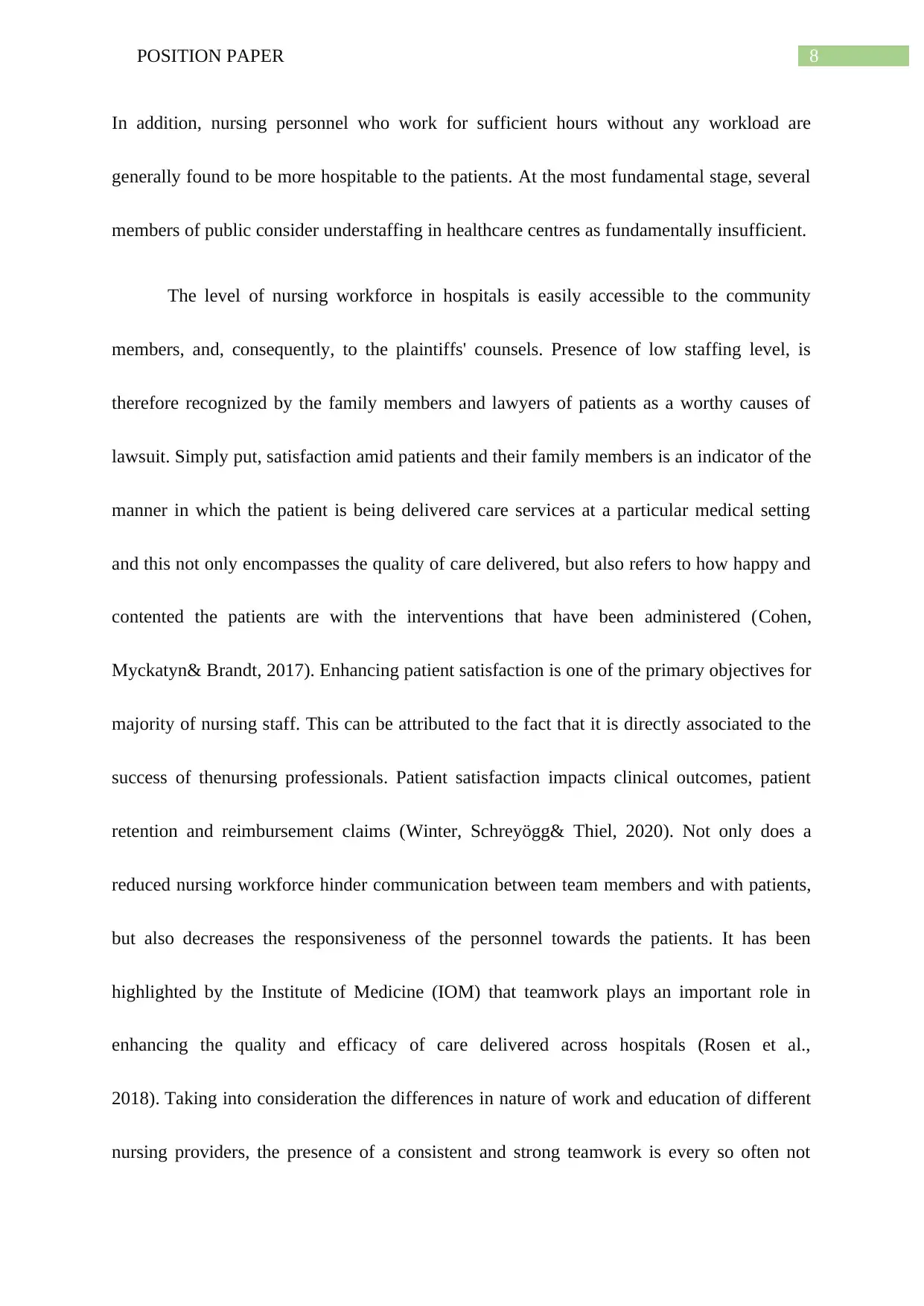
8POSITION PAPER
In addition, nursing personnel who work for sufficient hours without any workload are
generally found to be more hospitable to the patients. At the most fundamental stage, several
members of public consider understaffing in healthcare centres as fundamentally insufficient.
The level of nursing workforce in hospitals is easily accessible to the community
members, and, consequently, to the plaintiffs' counsels. Presence of low staffing level, is
therefore recognized by the family members and lawyers of patients as a worthy causes of
lawsuit. Simply put, satisfaction amid patients and their family members is an indicator of the
manner in which the patient is being delivered care services at a particular medical setting
and this not only encompasses the quality of care delivered, but also refers to how happy and
contented the patients are with the interventions that have been administered (Cohen,
Myckatyn& Brandt, 2017). Enhancing patient satisfaction is one of the primary objectives for
majority of nursing staff. This can be attributed to the fact that it is directly associated to the
success of thenursing professionals. Patient satisfaction impacts clinical outcomes, patient
retention and reimbursement claims (Winter, Schreyögg& Thiel, 2020). Not only does a
reduced nursing workforce hinder communication between team members and with patients,
but also decreases the responsiveness of the personnel towards the patients. It has been
highlighted by the Institute of Medicine (IOM) that teamwork plays an important role in
enhancing the quality and efficacy of care delivered across hospitals (Rosen et al.,
2018). Taking into consideration the differences in nature of work and education of different
nursing providers, the presence of a consistent and strong teamwork is every so often not
In addition, nursing personnel who work for sufficient hours without any workload are
generally found to be more hospitable to the patients. At the most fundamental stage, several
members of public consider understaffing in healthcare centres as fundamentally insufficient.
The level of nursing workforce in hospitals is easily accessible to the community
members, and, consequently, to the plaintiffs' counsels. Presence of low staffing level, is
therefore recognized by the family members and lawyers of patients as a worthy causes of
lawsuit. Simply put, satisfaction amid patients and their family members is an indicator of the
manner in which the patient is being delivered care services at a particular medical setting
and this not only encompasses the quality of care delivered, but also refers to how happy and
contented the patients are with the interventions that have been administered (Cohen,
Myckatyn& Brandt, 2017). Enhancing patient satisfaction is one of the primary objectives for
majority of nursing staff. This can be attributed to the fact that it is directly associated to the
success of thenursing professionals. Patient satisfaction impacts clinical outcomes, patient
retention and reimbursement claims (Winter, Schreyögg& Thiel, 2020). Not only does a
reduced nursing workforce hinder communication between team members and with patients,
but also decreases the responsiveness of the personnel towards the patients. It has been
highlighted by the Institute of Medicine (IOM) that teamwork plays an important role in
enhancing the quality and efficacy of care delivered across hospitals (Rosen et al.,
2018). Taking into consideration the differences in nature of work and education of different
nursing providers, the presence of a consistent and strong teamwork is every so often not
⊘ This is a preview!⊘
Do you want full access?
Subscribe today to unlock all pages.

Trusted by 1+ million students worldwide
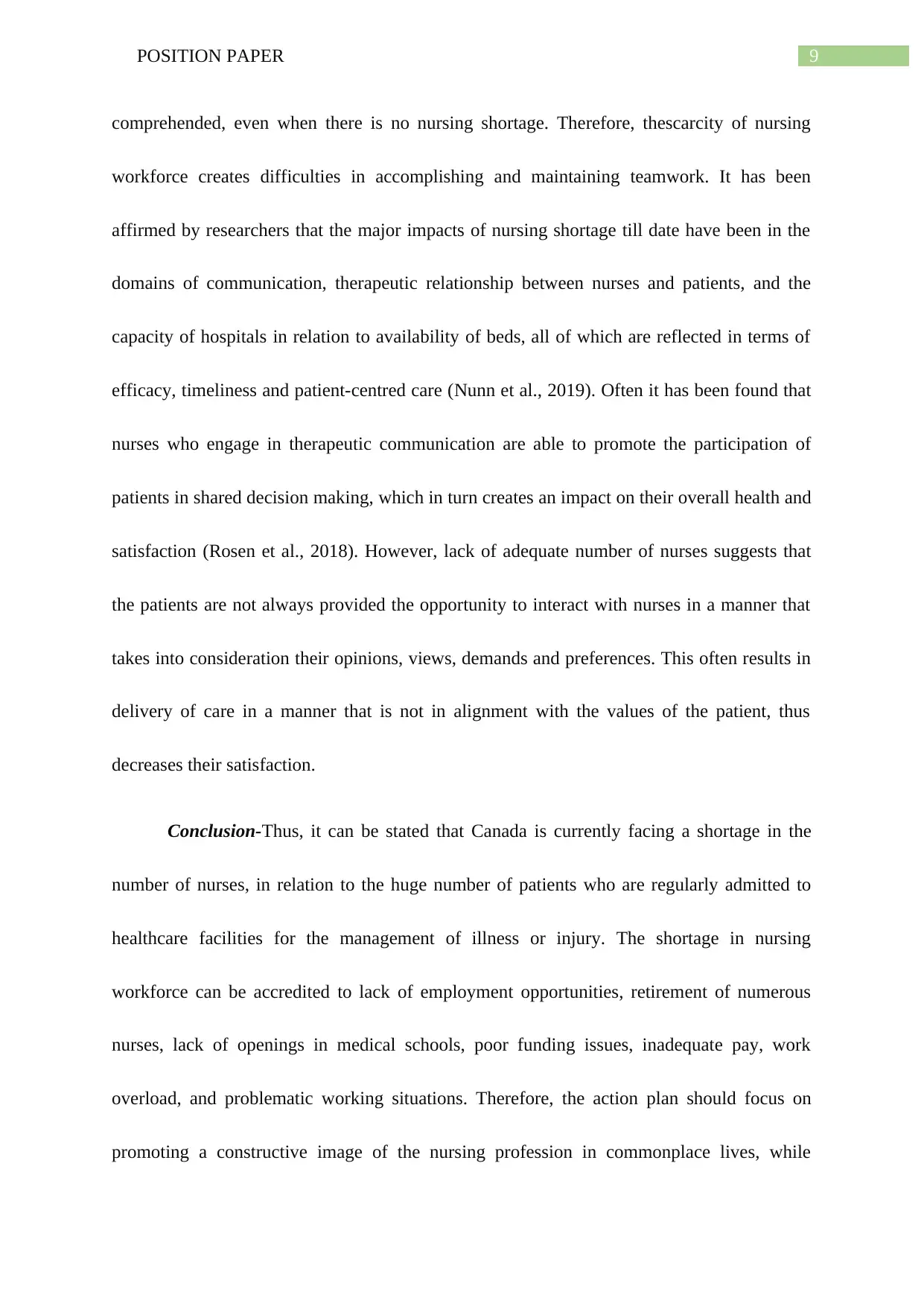
9POSITION PAPER
comprehended, even when there is no nursing shortage. Therefore, thescarcity of nursing
workforce creates difficulties in accomplishing and maintaining teamwork. It has been
affirmed by researchers that the major impacts of nursing shortage till date have been in the
domains of communication, therapeutic relationship between nurses and patients, and the
capacity of hospitals in relation to availability of beds, all of which are reflected in terms of
efficacy, timeliness and patient-centred care (Nunn et al., 2019). Often it has been found that
nurses who engage in therapeutic communication are able to promote the participation of
patients in shared decision making, which in turn creates an impact on their overall health and
satisfaction (Rosen et al., 2018). However, lack of adequate number of nurses suggests that
the patients are not always provided the opportunity to interact with nurses in a manner that
takes into consideration their opinions, views, demands and preferences. This often results in
delivery of care in a manner that is not in alignment with the values of the patient, thus
decreases their satisfaction.
Conclusion-Thus, it can be stated that Canada is currently facing a shortage in the
number of nurses, in relation to the huge number of patients who are regularly admitted to
healthcare facilities for the management of illness or injury. The shortage in nursing
workforce can be accredited to lack of employment opportunities, retirement of numerous
nurses, lack of openings in medical schools, poor funding issues, inadequate pay, work
overload, and problematic working situations. Therefore, the action plan should focus on
promoting a constructive image of the nursing profession in commonplace lives, while
comprehended, even when there is no nursing shortage. Therefore, thescarcity of nursing
workforce creates difficulties in accomplishing and maintaining teamwork. It has been
affirmed by researchers that the major impacts of nursing shortage till date have been in the
domains of communication, therapeutic relationship between nurses and patients, and the
capacity of hospitals in relation to availability of beds, all of which are reflected in terms of
efficacy, timeliness and patient-centred care (Nunn et al., 2019). Often it has been found that
nurses who engage in therapeutic communication are able to promote the participation of
patients in shared decision making, which in turn creates an impact on their overall health and
satisfaction (Rosen et al., 2018). However, lack of adequate number of nurses suggests that
the patients are not always provided the opportunity to interact with nurses in a manner that
takes into consideration their opinions, views, demands and preferences. This often results in
delivery of care in a manner that is not in alignment with the values of the patient, thus
decreases their satisfaction.
Conclusion-Thus, it can be stated that Canada is currently facing a shortage in the
number of nurses, in relation to the huge number of patients who are regularly admitted to
healthcare facilities for the management of illness or injury. The shortage in nursing
workforce can be accredited to lack of employment opportunities, retirement of numerous
nurses, lack of openings in medical schools, poor funding issues, inadequate pay, work
overload, and problematic working situations. Therefore, the action plan should focus on
promoting a constructive image of the nursing profession in commonplace lives, while
Paraphrase This Document
Need a fresh take? Get an instant paraphrase of this document with our AI Paraphraser
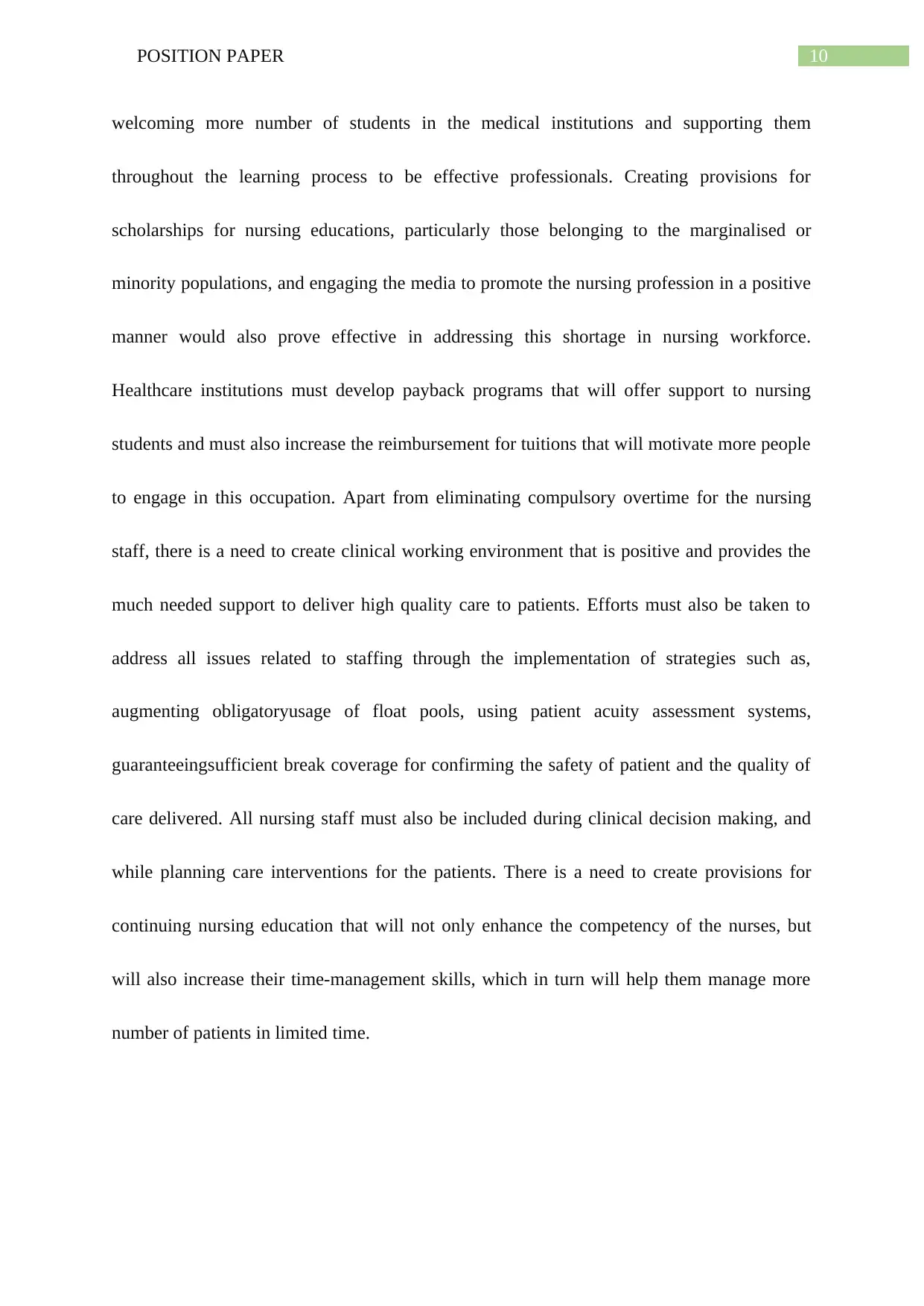
10POSITION PAPER
welcoming more number of students in the medical institutions and supporting them
throughout the learning process to be effective professionals. Creating provisions for
scholarships for nursing educations, particularly those belonging to the marginalised or
minority populations, and engaging the media to promote the nursing profession in a positive
manner would also prove effective in addressing this shortage in nursing workforce.
Healthcare institutions must develop payback programs that will offer support to nursing
students and must also increase the reimbursement for tuitions that will motivate more people
to engage in this occupation. Apart from eliminating compulsory overtime for the nursing
staff, there is a need to create clinical working environment that is positive and provides the
much needed support to deliver high quality care to patients. Efforts must also be taken to
address all issues related to staffing through the implementation of strategies such as,
augmenting obligatoryusage of float pools, using patient acuity assessment systems,
guaranteeingsufficient break coverage for confirming the safety of patient and the quality of
care delivered. All nursing staff must also be included during clinical decision making, and
while planning care interventions for the patients. There is a need to create provisions for
continuing nursing education that will not only enhance the competency of the nurses, but
will also increase their time-management skills, which in turn will help them manage more
number of patients in limited time.
welcoming more number of students in the medical institutions and supporting them
throughout the learning process to be effective professionals. Creating provisions for
scholarships for nursing educations, particularly those belonging to the marginalised or
minority populations, and engaging the media to promote the nursing profession in a positive
manner would also prove effective in addressing this shortage in nursing workforce.
Healthcare institutions must develop payback programs that will offer support to nursing
students and must also increase the reimbursement for tuitions that will motivate more people
to engage in this occupation. Apart from eliminating compulsory overtime for the nursing
staff, there is a need to create clinical working environment that is positive and provides the
much needed support to deliver high quality care to patients. Efforts must also be taken to
address all issues related to staffing through the implementation of strategies such as,
augmenting obligatoryusage of float pools, using patient acuity assessment systems,
guaranteeingsufficient break coverage for confirming the safety of patient and the quality of
care delivered. All nursing staff must also be included during clinical decision making, and
while planning care interventions for the patients. There is a need to create provisions for
continuing nursing education that will not only enhance the competency of the nurses, but
will also increase their time-management skills, which in turn will help them manage more
number of patients in limited time.
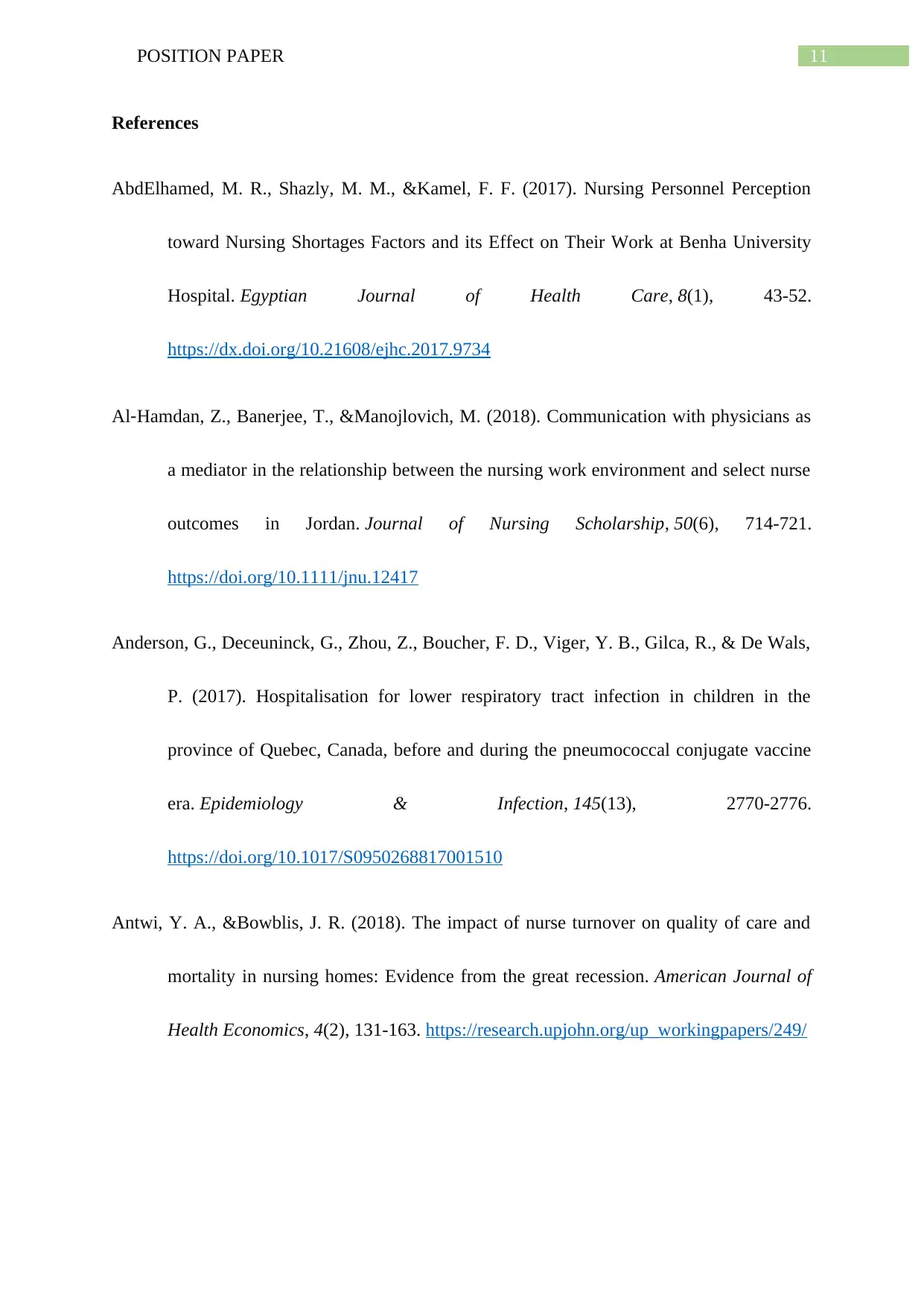
11POSITION PAPER
References
AbdElhamed, M. R., Shazly, M. M., &Kamel, F. F. (2017). Nursing Personnel Perception
toward Nursing Shortages Factors and its Effect on Their Work at Benha University
Hospital. Egyptian Journal of Health Care, 8(1), 43-52.
https://dx.doi.org/10.21608/ejhc.2017.9734
Al‐Hamdan, Z., Banerjee, T., &Manojlovich, M. (2018). Communication with physicians as
a mediator in the relationship between the nursing work environment and select nurse
outcomes in Jordan. Journal of Nursing Scholarship, 50(6), 714-721.
https://doi.org/10.1111/jnu.12417
Anderson, G., Deceuninck, G., Zhou, Z., Boucher, F. D., Viger, Y. B., Gilca, R., & De Wals,
P. (2017). Hospitalisation for lower respiratory tract infection in children in the
province of Quebec, Canada, before and during the pneumococcal conjugate vaccine
era. Epidemiology & Infection, 145(13), 2770-2776.
https://doi.org/10.1017/S0950268817001510
Antwi, Y. A., &Bowblis, J. R. (2018). The impact of nurse turnover on quality of care and
mortality in nursing homes: Evidence from the great recession. American Journal of
Health Economics, 4(2), 131-163. https://research.upjohn.org/up_workingpapers/249/
References
AbdElhamed, M. R., Shazly, M. M., &Kamel, F. F. (2017). Nursing Personnel Perception
toward Nursing Shortages Factors and its Effect on Their Work at Benha University
Hospital. Egyptian Journal of Health Care, 8(1), 43-52.
https://dx.doi.org/10.21608/ejhc.2017.9734
Al‐Hamdan, Z., Banerjee, T., &Manojlovich, M. (2018). Communication with physicians as
a mediator in the relationship between the nursing work environment and select nurse
outcomes in Jordan. Journal of Nursing Scholarship, 50(6), 714-721.
https://doi.org/10.1111/jnu.12417
Anderson, G., Deceuninck, G., Zhou, Z., Boucher, F. D., Viger, Y. B., Gilca, R., & De Wals,
P. (2017). Hospitalisation for lower respiratory tract infection in children in the
province of Quebec, Canada, before and during the pneumococcal conjugate vaccine
era. Epidemiology & Infection, 145(13), 2770-2776.
https://doi.org/10.1017/S0950268817001510
Antwi, Y. A., &Bowblis, J. R. (2018). The impact of nurse turnover on quality of care and
mortality in nursing homes: Evidence from the great recession. American Journal of
Health Economics, 4(2), 131-163. https://research.upjohn.org/up_workingpapers/249/
⊘ This is a preview!⊘
Do you want full access?
Subscribe today to unlock all pages.

Trusted by 1+ million students worldwide
1 out of 17
Related Documents
Your All-in-One AI-Powered Toolkit for Academic Success.
+13062052269
info@desklib.com
Available 24*7 on WhatsApp / Email
![[object Object]](/_next/static/media/star-bottom.7253800d.svg)
Unlock your academic potential
Copyright © 2020–2025 A2Z Services. All Rights Reserved. Developed and managed by ZUCOL.





